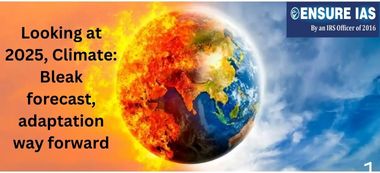- Courses
- GS Full Course 1 Year
- GS Full Course 2 Year
- GS Full Course 3 Year
- GS Full Course Till Selection
- Online Program
- GS Recorded Course
- NCERT (Recorded 500+ Hours)
- Polity Recorded Course
- Geography Recorded Course
- Economy Recorded Course
- AMAC Recorded Course
- Modern India, Post Independence & World History
- Environment Recoded Course
- Governance Recoded Course
- Science & Tech. Recoded Course
- International Relations and Internal Security Recorded Course
- Disaster Management Module Course
- Ethics Recoded Course
- Essay Recoded Course
- Current Affairs Recoded Course
- CSAT
- 5 LAYERED ARJUNA Mentorship
- Public Administration Optional
- ABOUT US
- OUR TOPPERS
- TEST SERIES
- FREE STUDY MATERIAL
- VIDEOS
- CONTACT US
Looking at 2025, Climate: Bleak forecast, adaptation way forward
Looking at 2025, Climate: Bleak forecast, adaptation way forward

- The year 2024 marks a critical turning point in the global climate crisis. The 1.5°C threshold — one of the key goals of the 2015 Paris Agreement on climate change — was officially breached for the first time.
- While this milestone highlights the failure of global climate efforts, it also highlights the urgent need for adaptation alongside mitigation strategies.
- The temperature rise has already surpassed the 1.5°C mark, and the possibility of limiting it within that threshold appears highly unlikely.
- This situation forces the world to confront the current climate realities and adopt strategies that can help mitigate the impacts of rising temperatures.
- However, the challenge is monumental, as it involves emission reductions, financial commitments, and the implementation of climate adaptation measures, particularly in vulnerable countries.
1. The 1.5°C Target: Out of Reach
- The Paris Agreement (2015) set a goal to limit global warming to well below 2°C, with a more ambitious target of 1.5°C above pre-industrial levels.
- At the time, it seemed feasible, as the global temperature had not yet risen by 1°C.
- However, since the Paris Agreement, the pace of warming has dramatically accelerated.
- 2024 will be the warmest year on record, surpassing the 1.5°C mark, indicating the near impossibility of reaching the goal.
IPCC Report (2024):
- According to the Intergovernmental Panel on Climate Change (IPCC), to stay within the 1.5°C limit, global greenhouse gas emissions would need to be reduced by at least 43% from 2019 levels by 2030.
- However, current policies and climate actions across the globe are expected to result in only a 2% reduction in emissions by 2030, far from the 43% needed.
- Emissions Gap: There is a massive gap between the required emissions reductions and what is being achieved, making the 1.5°C target virtually impossible to meet.
COP29 (2024):
- The COP29 summit held in Baku, Azerbaijan, was seen as a critical moment for climate action.
- It was expected to result in an agreement to increase funding for climate actions, with trillions of dollars needed annually.
- However, developed countries only agreed to contribute a measly $300 billion per year, and that too, only from 2035.
- This financial commitment is insufficient to close the emissions gap or fund the necessary adaptation measures.
2. Record-Breaking Warming: The 2024 Data
- 2024 is on track to be the warmest year ever recorded, with a global temperature at least 1.55°C above pre-industrial levels.
- Copernicus Climate Change Service (2024) reported that the 12-month period from November 2023 to October 2024 saw a temperature increase of about 1.62°C above pre-industrial levels.
- June 2023 marked the first time that the global monthly average temperature exceeded the 1.5°C threshold for an entire month.
- Temperature Exceedance: In 2023, 173 days exceeded 1.5°C warming above pre-industrial levels.
- On two separate occasions in November 2023, temperatures exceeded the 2°C mark for the first time in recorded history.
- Extreme Weather Events: The continuous rise in temperature has led to unprecedented heatwaves, wildfires, storms, and flooding.
3. Global Climate Response: Weak and Ineffective
The global response to these escalating climate impacts has been subpar and fragmented, with key countries failing to meet their climate commitments.
The United States:
- Despite being the largest historical emitter of greenhouse gases (about 25% of global emissions since industrialization), the US has not led by example.
- Donald Trump’s potential re-entry into the White House raises concerns about a renewed withdrawal from the Paris Agreement.
- This would signal a retreat from international climate commitments and could inspire other nations to follow suit.
- US Emissions Target: The US has set a target of reducing emissions by 50-52% by 2030 (compared to 2005 levels), which is barely sufficient to meet global climate goals.
- The US's share of historical emissions and its failure to take robust action means it must do more than other nations to meet its responsibilities.
China:
- China has been the world’s largest emitter of greenhouse gases since 2006 and is the second-largest contributor to historical emissions (behind the US).
- It is responsible for about 12% of emissions since 1850.
- Despite massive investments in renewable energy (solar and wind), China's emissions have continued to rise, primarily due to its reliance on coal.
- As a developing country, China has no legally binding requirement under the Paris Agreement to reduce emissions at the same pace as developed nations, even though its carbon footprint is larger than the European Union’s.
- China's Potential to Cut Emissions: China could significantly reduce emissions once it reaches peak emissions, which could happen anytime soon.
- Its leadership in renewable energy infrastructure places it in a critical position for driving global climate action post-2030.
Developing Countries' Challenges:
- Developing nations, especially small island states, are disproportionately impacted by climate change but lack the financial resources to implement adaptation measures.
- International Climate Finance: The failure of developed countries to meet their commitments for climate finance has exacerbated the vulnerability of these nations.
- Adaptation Needs: Vulnerable countries need funds to implement disaster-resistant infrastructure, early warning systems, and resilient agriculture to safeguard their populations from extreme weather events.
4. Adaptation: The Critical Focus
Since the goal of staying below 1.5°C is likely unattainable, the focus must shift toward climate adaptation, particularly for countries already facing severe impacts from climate change.
Early Warning Systems (EWS):
- More than half of the countries globally lack effective early warning systems for climate-related disasters, such as cyclones, floods, and heatwaves.
- The World Meteorological Organization (WMO)'s "Early Warnings for All" initiative aims to set up these systems in every country to better prepare for extreme weather events.
Technology and Innovation:
- Rapid advances in artificial intelligence (AI), quantum computing, and biotechnology offer promising solutions for both mitigation and adaptation.
- AI and Quantum Science are being deployed to improve energy efficiency, develop carbon capture technologies, and enhance battery storage to support the transition to renewable energy.
- China’s leadership in renewable energy infrastructure provides a potential model for how massive-scale renewables can significantly reduce emissions in the post-2035 period.
Financial Support for Developing Nations:
- The international community must provide funding and technological expertise to help developing countries implement their climate adaptation plans.
- Climate finance remains a major bottleneck, with developed countries falling short of the $100 billion annually promised to developing nations to support climate actions.
5. Looking Ahead: The Post-2035 Era
While it may no longer be realistic to stay within the 1.5°C limit, the global focus should now be on achieving net-zero emissions by 2050. This is still possible if immediate steps are taken, such as:
- Transitioning from fossil fuels to renewable energy (solar, wind, and green hydrogen).
- Increased reliance on carbon capture and storage (CCS) and carbon removal technologies.
- Accelerated decarbonization in sectors like transportation, industry, and agriculture.
- Technological breakthroughs could help overcome barriers to rapid transitions, such as energy storage and grid infrastructure improvements.
Conclusion: A Call for Immediate Action
The 1.5°C target may no longer be achievable, but that does not mean the world is doomed. Immediate and decisive action is needed in two areas:
- Mitigation: Drastically reducing emissions in the post-2035 period is crucial to limit global warming to safe levels by 2050.
- Adaptation: In the short term, vulnerable countries need urgent assistance to cope with climate impacts. Effective early warning systems, disaster-resistant infrastructure, and climate financing are critical for helping these nations build resilience.
While the window for climate action is closing fast, the shift to a sustainable, low-carbon future remains possible — if nations, especially the major emitters, show the necessary political will and collaboration.
While the window for climate action is closing fast, the shift to a sustainable, low-carbon future remains possible — if nations, especially the major emitters, show the necessary political will and collaboration.
|
Also Read |
|




